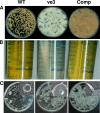Regulation of morphogenesis and biocontrol properties in Trichoderma virens by a VELVET protein, Vel1
- PMID: 20154111
- PMCID: PMC2849264
- DOI: 10.1128/AEM.02391-09
Regulation of morphogenesis and biocontrol properties in Trichoderma virens by a VELVET protein, Vel1
Abstract
Mycoparasitic strains of Trichoderma are applied as commercial biofungicides for control of soilborne plant pathogens. Although the majority of commercial biofungicides are Trichoderma based, chemical pesticides, which are ecological and environmental hazards, still dominate the market. This is because biofungicides are not as effective or consistent as chemical fungicides. Efforts to improve these products have been limited by a lack of understanding of the genetic regulation of biocontrol activities. In this study, using gene knockout and complementation, we identified the VELVET protein Vel1 as a key regulator of biocontrol, as well as morphogenetic traits, in Trichoderma virens, a commercial biocontrol agent. Mutants with mutations in vel1 were defective in secondary metabolism (antibiosis), mycoparasitism, and biocontrol efficacy. In nutrient-rich media they also lacked two types of spores important for survival and development of formulation products: conidia (on agar) and chlamydospores (in liquid shake cultures). These findings provide an opportunity for genetic enhancement of biocontrol and industrial strains of Trichoderma, since Vel1 is very highly conserved across three Trichoderma species.
Figures







Similar articles
-
TBRG-1 a Ras-like protein in Trichoderma virens involved in conidiation, development, secondary metabolism, mycoparasitism, and biocontrol unveils a new family of Ras-GTPases.Fungal Genet Biol. 2020 Mar;136:103292. doi: 10.1016/j.fgb.2019.103292. Epub 2019 Nov 12. Fungal Genet Biol. 2020. PMID: 31730908
-
cAMP signalling is involved in growth, germination, mycoparasitism and secondary metabolism in Trichoderma virens.Microbiology (Reading). 2007 Jun;153(Pt 6):1734-1742. doi: 10.1099/mic.0.2007/005702-0. Microbiology (Reading). 2007. PMID: 17526831
-
Improvement of the fungal biocontrol agent Trichoderma atroviride to enhance both antagonism and induction of plant systemic disease resistance.Appl Environ Microbiol. 2005 Jul;71(7):3959-65. doi: 10.1128/AEM.71.7.3959-3965.2005. Appl Environ Microbiol. 2005. PMID: 16000810 Free PMC article.
-
Trichoderma: sensing the environment for survival and dispersal.Microbiology (Reading). 2012 Jan;158(Pt 1):3-16. doi: 10.1099/mic.0.052688-0. Epub 2011 Sep 29. Microbiology (Reading). 2012. PMID: 21964734 Review.
-
Trichoderma Species: Our Best Fungal Allies in the Biocontrol of Plant Diseases-A Review.Plants (Basel). 2023 Jan 17;12(3):432. doi: 10.3390/plants12030432. Plants (Basel). 2023. PMID: 36771517 Free PMC article. Review.
Cited by
-
Role of the Global Fitness Regulator Genes on the Osmotic Tolerance Ability and Salinity Hazard Alleviation of Trichoderma asperellum GDFS 1009 for Sustainable Agriculture.J Fungi (Basel). 2022 Nov 8;8(11):1176. doi: 10.3390/jof8111176. J Fungi (Basel). 2022. PMID: 36354943 Free PMC article.
-
Whole Genome Sequencing Reveals Major Deletions in the Genome of M7, a Gamma Ray-Induced Mutant of Trichoderma virens That Is Repressed in Conidiation, Secondary Metabolism, and Mycoparasitism.Front Microbiol. 2020 Jun 12;11:1030. doi: 10.3389/fmicb.2020.01030. eCollection 2020. Front Microbiol. 2020. PMID: 32595612 Free PMC article.
-
Transcriptional regulatory elements in fungal secondary metabolism.J Microbiol. 2011 Jun;49(3):329-39. doi: 10.1007/s12275-011-1009-1. Epub 2011 Jun 30. J Microbiol. 2011. PMID: 21717315 Free PMC article. Review.
-
Repression of tropolone production and induction of a Burkholderia plantarii pseudo-biofilm by carot-4-en-9,10-diol, a cell-to-cell signaling disrupter produced by Trichoderma virens.PLoS One. 2013 Nov 4;8(11):e78024. doi: 10.1371/journal.pone.0078024. eCollection 2013. PLoS One. 2013. PMID: 24223754 Free PMC article.
-
Biological Management of Banana Fusarium Wilt Caused by Fusarium oxysporum f. sp. cubense Tropical Race 4 Using Antagonistic Fungal Isolate CSR-T-3 (Trichoderma reesei).Front Microbiol. 2020 Dec 16;11:595845. doi: 10.3389/fmicb.2020.595845. eCollection 2020. Front Microbiol. 2020. PMID: 33391212 Free PMC article.
References
-
- Baek, J. M., and C. M. Kenerley. 1998. The arg2 gene of Trichoderma virens: cloning and development of a homologous transformation system. Fungal Genet. Biol. 23:34-44. - PubMed
-
- Baek, J. M., C. R. Howell, and C. M. Kenerley. 1999. The role of an extracellular chitinase from Trichoderma virens Gv29-8 in the biocontrol of Rhizoctonia solani. Curr. Genet. 35:41-50. - PubMed
-
- Bayram, O., S. Krappmann, M. Ni, J. W. Bok, K. Helmstaedt, O. Valerius, S. Braus-Stromeyer, N. J. Kwon, N. P. Keller, J. H. Yu, and G. H. Braus. 2008. VelB/VeA/LaeA complex coordinates light signal with fungal development and secondary metabolism. Science 320:1504-1506. - PubMed
-
- Bayram, O., S. Krappmann, S. Seiler, N. Vogt, and G. H. Braus. 2008. Neurospora crassa ve-1 affects asexual conidiation. Fungal Genet. Biol. 45:127-138. - PubMed
-
- Beagle-Ristaino, J. E., and G. C. Papavizas. 1985. Survival and proliferation of propagules of Trichoderma spp. and Gliocladium virens in soil and in plant rhizospheres. Phytopathology 75:729-732.
Publication types
MeSH terms
Substances
LinkOut - more resources
Full Text Sources
Other Literature Sources

